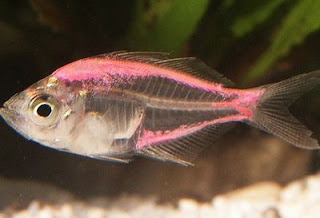The Indian glassy fish has a striking transparent body revealing its bones and internal organs; the male develops a dark edge to the dorsal fin.
The Indian glassy fish, Parambassis ranga, is a species of freshwater fish in the Asiatic glassfish family (family Ambassidae) of order Perciformes. The fish grows to a maximum overall length of 80 millimetres (3.1 in). It occurs in standing water, especially in impoundments, and it breeds prolifically during the rainy season. The species feeds on crustaceans, annelid worms, and other invertebrates. It is in turn prey for larger fish, including snakeheads (family Channidae).
Glassfish have been kept in aquarium for many years, but have a reputation for being delicate and difficult to keep. This may be related to a persistent myth that these fish need brackish water. In the wild they more commonly inhabit freshwater, and in captivity do well in slightly soft to moderately hard dGH 7–19, slightly acidic to slightly alkaline water pH 6.5–7.5. They can tolerate a temperature range of 20–30 °C (68–86 °F).
Disco Fish (Dyed Glassfish)
Indian glassy fish sold to hobbyists have often been "painted", which involves injecting coloured dye into the fish's transparent tissue to make them more attractive to hobbyists. These coloured fish are often called "disco fish". Inexperienced fishkeepers are often tricked into believing such fish are natural or that the process is painless and causes no harm.
Fish thus treated have suffered trauma and are susceptible to disease, including ich, fin rot and the viral disease Lymphocystis. The artificial coloration often fades within a short time. Healthy, non-"painted" specimens may live three to four years in captivity, but such individuals may be difficult to find in some localities.









0 comments:
Post a Comment